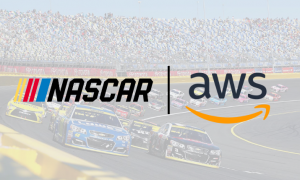NASCAR Partners With AWS To Speed Up its Archive
The cloud-based content will be more secure and available from anywhere
Story Highlights
NASCAR measures its video archive in petabytes: 18 PB at the moment, representing 75 years of digitized content. That’s a lot of laps. At the moment, that vast collection is stored locally at the company’s Charlotte, NC, headquarters on Spectra Logic tape robots and hard drives. Soon, it will all move to the cloud, under an agreement that NASCAR has signed with AWS Elemental, becoming safer and a lot more useful.
 Once the full archive is stored with AWS in multiple redundant locations, the collection will be more secure than it is now, but that’s only one reason for the move. AWS will use artificial intelligence and machine learning to create detailed metadata for each piece of video. Once that’s done, NASCAR producers working in any location will be able to reach to the cloud for a specific clip, get it in seconds, and insert it into whatever new piece of content they’re working on.
Once the full archive is stored with AWS in multiple redundant locations, the collection will be more secure than it is now, but that’s only one reason for the move. AWS will use artificial intelligence and machine learning to create detailed metadata for each piece of video. Once that’s done, NASCAR producers working in any location will be able to reach to the cloud for a specific clip, get it in seconds, and insert it into whatever new piece of content they’re working on.
The timing is right for a move to the cloud, says Steve Stum, VP, operations and technical production, NASCAR. The company has been considering such a move for three or four years and interviewed a variety of contenders — including Microsoft, AT&T, and Google — about making it happen. However, AWS and its AI and machine-learning experience came out on top.
So far, adding metadata has been a manual process for NASCAR. Keeping track of the lap each car is on and identifying logos is a mind-numbing task best left to computers. Before signing on with AWS, the two companies ran preliminary tests to see how effective an automated solution could be. The solution needs to pick out sponsor logos on billboards and car hoods, identify the faces of drivers and crew chiefs, and print up sponsor reports. An automated system will save NASCAR a huge amount of time.
“We show that our manual logging process, which is a group of entry-level people searching through [footage], is about 20% efficient; we’re taking about an hour to do five hours of footage. We’re proving out that we can probably get [the process] up to 85% or 90% efficient through machine-learning and some automation,” Stum says. “We hope to extend that, which allows us a lot of metadata that we can search by and create an automated search. Like you would go online now and look at a search engine and find footage quickly. We’re hoping to get that implemented pretty soon.”
NASCAR’s archive doesn’t gather dust. The company uses it to produce content for its broadcast partners, such as NASCAR Race Hub. Its Truck Series, Xfinity Series, and broadcast partners Fox and NBC use archived content.
Naturally, NASCAR uses the archives for its internal projects, such as the documentaries it creates throughout the year. Likewise, post-event shows, live streams from the track, and weekly shows and highlights all rely on the archive.
Although the archive isn’t open to the public now, that could change. As the archive moves to the cloud, Stum sees an opportunity to create fan-facing applications or gather video through crowd-sourcing.
Latency is an issue for live video streaming, but it’s a concern for a cloud-based archive as well. If a producer is covering a race in Michigan and wants to refer to something Richard Petty did in the 1970s, he or she might not have it handy on hard drives in the production truck. In that case, turning to a cloud archive and getting the clip in seconds would be extremely valuable.
Live Video to the Cloud
Besides uploading its archives, NASCAR is pivoting to a fully cloud-based workflow, with live video from the track — multiple streams from each event — going directly online. Currently, when editing a piece, producers now have to request clips and download them, but, in the future, producers will edit directly in the cloud. The entire workflow is moving online and should be in place next year.
It takes several partners to deliver NASCAR’s race-day excitement: AWS Elemental and Comcast provide connectivity from the track, Xfinity sponsors the K&N series, Arris is a major infrastructure partner, and Omnigon manages the website. It’s all to satisfy one of the most passionate and vocal fan bases in all of sports.
“NASCAR’s about the fans: the excitement and technology driving our sport to a place it’s never been before to get it into the hands of the fans and the consumers quicker and better and more far-reaching,” Stum says. “With Elemental’s reach around the world, it gives us the opportunity to push it out — whether for digital OTT or over-the-air — to places we never could have gone on our own.”
